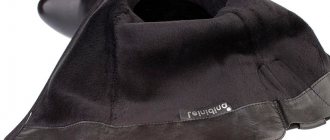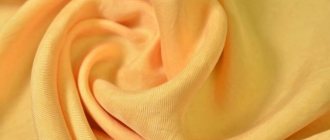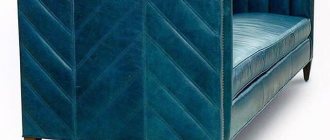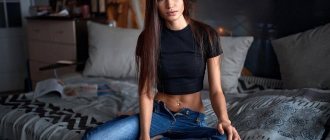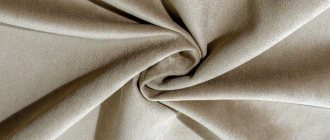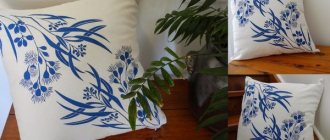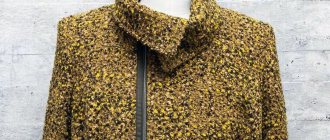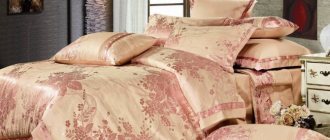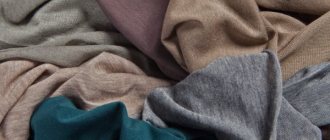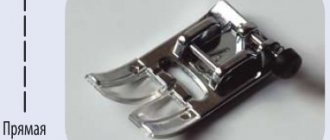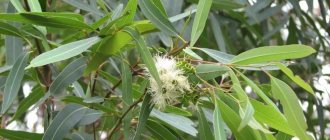Tencel is considered a trade name for environmentally friendly lyocell fibers. It is a relatively new material, has excellent quality and technical characteristics, which can be on par with cotton and silk. In the article we will tell you: Tencel, what kind of material it is, where it came from, what it consists of, and we will give the technical characteristics of the fabric.
History of creation
Many, having seen the word “Tensel” on the labels, begin to ask questions - what kind of fabric is this? The material itself is considered a modern invention, produced using the latest nanotechnology.
The discoverer of this material was England, namely the company Courtaulds Fibers UK. The company is engaged in the production of textiles and in 1988, they decided to try using ordinary eucalyptus fiber instead of raw materials. The experiment yielded positive results and became a success for the company, which managed to produce a previously unused material - lyocell fiber.
Later, from the so-called “lyocell”, a completely new fabric was produced, which was called tencel. The creators of the material immediately realized that the material was made of high quality and would gain worldwide popularity.
In 1991, the company released the material it created to a wider public. And exactly a year later, about 18,000 tons of Tencel were produced, which began to gain momentum in popularity. 6 years after the expanded show, in 1997, mass production of this material was launched.
In 2000, one of the Australian companies decided to buy the lyocell manufacturing technology, which they soon promised to bring to the world level and make it as popular as possible. World fame did not come immediately, but exactly 2 years later, the fabric itself became popular all over the world, and meanwhile production was in full swing.
The material is of high quality, but it still doesn’t have an exact name. In Russia it is customary to call it by two names - Tencel or Tencel.
What are they making?
Like cotton and bamboo, tencel is well suited for smooth fabrics and terry cloth. Therefore, smooth and terry towels, bathrobes and bed linen are sewn from it.
In addition, outerwear, casual and festive clothes, and underwear are sewn from Tencel.
The fabric is in demand both in industry (due to its absorbent properties) and in medicine (safe and hypoallergenic), for the manufacture of packaging materials (ropes, ropes, cables).
Composition and properties
Since the material is considered too expensive, it is usually mixed with cotton, silk or synthetic fibers to make it available to everyone. Many people have a question: what kind of material is tencel, what are its characteristics and what percentage of lyocel should be in it for its name to be that. The world standard states that a material has the right to be called “Tensel” if it contains 30 percent lyocel or more.
Regarding the properties of the fabric itself, it is considered unique in all respects.
Clothing made from this material allows the skin to be completely free and breathe even under a tight outfit. A person who wears this fabric even in hot weather will feel cool and completely fresh. In addition, the power of the ability to “breathe” allows matter not only to absorb moisture, but also to evaporate it just as quickly, which allows bacteria not to stagnate and multiply.
Things made from Tencel are hypoallergenic, have high performance characteristics, are wear-resistant if the necessary rules are followed, and are not electrified.
Tencel is considered something unique for active environmentalists. Due to its unique production properties, made exclusively from natural materials, it is a fairly biodegradable matter. In addition, the fabric is made from eucalyptus wood shavings, which in turn has healing properties that have a beneficial effect on the human body, absorbs human diseases and serves as an excellent immunity booster.
What does Tencel contain?
If a product is labeled as Tencel 100, this means that it is free of any impurities. Often, to reduce the cost of the material, manufacturers add fibers of cotton, bamboo, wool and other components. Our website offers high quality designer textiles. It does not contain substances that reduce the properties of Tencel. The catalog presents a large selection of luxury lingerie made from this innovative material. You can also buy satin bed linen in the Bedream online store.
Characteristics of Tencel
Tencel fabric is very pleasant to the touch, which allows you to choose it when purchasing. It fits perfectly on the body, is pleasant, and is hygroscopic: this is the kind of clothing you should wear and you won’t sweat in it.
Despite its main advantages and positive characteristics, the fabric also has disadvantages:
- The material is prone to shrinkage, which is why it is correct to do the washing and read as many recommendations as possible. Also, in addition to additional recommendations, when purchasing, you can read on the label what and how to do.
- If worn incorrectly, the fabric can also stretch, which therefore indicates low elasticity of the material.
- When purchasing Tencel bed linen, it is not recommended to wash it like other types of linen, but only dry clean it.
The material can be of two types to the touch, everything will depend on the clothing and the manufacturer itself. The first type is distinguished by its subtlety, tenderness and perfect smoothness. But the second one is considered rougher, with a velvety surface, basically reminiscent of a ripe peach.
Varieties
Types of Tencel fabric can be classified by texture, composition, and pattern.
Based on texture, the material is divided into:
- velvety;
- smooth.
Artificial and chemical fibers are prone to fibrillization - splitting of the thread and the appearance of villi on it. As a result, “pellets” appear on the fabric. Technologists managed to turn this drawback into an exclusive feature by specially fluffing the fibers. The finished, colored Tencel material is mechanically processed with abrasives, resulting in a “peach skin” effect.
Without the use of this technology, the fabric has a smooth silky structure. You can find satin tencel on the market. Satin is a type of fabric with a special weave of threads that gives the front side smoothness and shine. Satin was made from silk and cotton threads. Now you can buy Tencel satin, including with the addition of cotton.
Wool is also added to the material, achieving excellent thermal and moisture-wicking properties. Thermal underwear made from it is in high demand.
A complex composition with polyester fibers is possible. The mixture may contain polyester, nylon, spandex, viscose, etc. Depending on the composition and manufacturing technology, the fabric can be elastic, light, like crepe, or knitted. Manufacturers offer a huge number of options, sometimes using the name “politensel”.
Any design can be applied to tencel. Delicate drawings on a smooth surface look especially touching. The jacquard pattern on the material creates a solemn, festive atmosphere.
Production
The production of Tencel is 100% safe for the environment and ecology. It is because of this that the material is so popular among wildlife lovers.
Fibers are obtained from the woody part of cellulose. Instead of raw materials, shavings of Australian eucalyptus trees are most often used, which are grown on designated farms and located in environmentally friendly areas, completely eliminating the addition of additives for fertilizers and herbicides.
Wood shavings, which are used in the course of work, are usually crushed using an organic solvent, after which a mass is obtained, which is passed through specialized molds with small holes. The next step is drying, complete washing and a special pressing method.
Next, it is customary to twist threads from lyocell, or combine them with other types of fibers to obtain a mixed constriction. It is usually combined with cotton, wool, silk and other more durable fibers. In order for a material to be called Tencel, it must contain at least 30 percent lyocell.
The manufacturing process itself is quite complex: initially, a single mass of wood pulp is obtained from eucalyptus wood. Afterwards, threads are formed from this mass by pressing through dies in acidic compounds. The composition itself is used in its entirety, one per batch of cellulose pulp, waste is prohibited from being thrown away, and the production itself is closed and cyclical.
The final stage is drying. All the resulting material can be dyed, and the dye itself adheres well and adheres firmly to the material, which is why the fabric eliminates shedding and fading. Completely pure fiber is considered very expensive, so most often they try to mix it with cotton, bamboo fibers, as well as wool and viscose.
People believe that tencel production is considered to be as much as 100 times safer and less harmful to the environment than cotton production.
Description of the manufacturing process
Initially, coniferous wood was used for production. Currently, different plants are used in the technological process. Some manufacturers specify where the raw materials grow, for example, Australian eucalyptus.
The difference between cellulose processing in the production of lyocell is the use of an organic solvent. It does not have harmful decomposition products and is self-healing, so production is environmentally friendly. Thanks to this, the number of stages of the technical process has also been reduced. As in the production of viscose, cellulose is pulled into threads, passed through thin holes, and dried. The resulting lyocell fibers have the same raw materials and chemical composition as viscose. But due to different technical processes, the properties of the fabrics made from them differ.
Types and features
From the external and tactile part, Tencel has two types:
- Soft and delicate cover;
- Smooth and rough, with a glossy sheen present.
The composition of natural material is:
- One hundred percent (Completely pure Tencel, which is distinguished by quality, excellent characteristics and high price);
- Combined (Adding other types of mothers to get accessible material for any person, while no worse in quality than one hundred percent).
In the second case, fibers are added, which make the material more economical and increase its strength. The following additives are often used: wool, cotton, viscose and bamboo fibers.
Comparison with other materials
We can say that tencel is similar to silk and cotton in almost all its characteristics; the difference lies in the price of such materials. It is also much better than even the highest grade cotton and is perfect for people with sensitive skin. In addition, unlike silk, linen and cotton, Tencel has high bactericidal properties, thanks to which the material prevents the development of microorganisms.
It also differs in the following parameters:
- Its softness is similar to silk.
- The safety margin is much greater than that of flax.
- Pleasant to the body, unlike cotton.
- It warms well, but also cools well in hot weather.
Fabric comparison
Application
Thanks to the unique properties of Tencel fabric, it will suit absolutely everyone, without exception. It can be used for household, medical, technical and personal needs.
If you rely on reviews, you can find a lot of positive emotions from people who have sensitive skin, who suffer from skin irritations and diseases, and how they praise this fabric. The fabric is considered beneficial for every person, even those who are allergic to synthetic fibers.
The material is actively used for the manufacture of children's items, diapers and nappies, so that the newborn baby always remains in comfortable and non-irritating conditions.
Casual clothing is also made from Tencel. It is mainly used for sportswear and elite class bedding. It is actively used in the production of underwear, dressing gowns and towels. It is also actively developing in the automotive sector, producing dressing kits for automobile and hydraulic filters.
Fabric use
Thanks to natural fibers, when in contact with the human body, Tencel creates a comfortable environment. In hot weather it cools, and in low temperatures it warms. Therefore, premium bed linen is made from tencel.
It gives a gentle touch, but does not slip. You don't have to iron it, because... even after washing it looks aesthetically pleasing. Temperature heating with an iron is also not required to destroy microorganisms in bed linen. Manufacturers of eucalyptus fabric guarantee its antibacterial properties.
Tencel blouse
tencel pajamas
tencel blanket
tencel sleep mask
Tencel is also used to make tablecloths, bedspreads, curtains, and decorative pillows.
The material is excellent for sewing clothes, including children's ones. It will not wrinkle, so it is good for wearing dresses, sundresses, skirts and blouses. Draps beautifully and can be used to create evening looks. It is better to sew flowing, loose-fitting models from this thin fabric; do not hug the body.
A blouse made of smooth tencel looks good with a pencil skirt made of wool, suiting fabric or suede. Blouses and tops are in harmony with both classic and tapered trousers and jeans.
Tencel jumpsuits with large pajama-style prints look ultra-fashionable. This bold model is suitable for girls with a slender figure.
A growing trend is jeans made from Tencel, which provide increased comfort. There are also moral, ethical and environmental components to this topic. According to experts, unpaid and child labor is used in the cotton harvest. One pair of cotton jeans requires a colossal amount of water - 10 thousand liters. In this regard, more than 20 brands in Europe and the USA have refused to import it in recent years.
To personally appreciate the unique quality of the fabric, you can order a neckerchief or scarf from it. It will transform any clothing, making the image individual, and help you create your own opinion about the fabric.
Advice. Jewelry on the neck is not worn with colorful clothing or when using a neckerchief.
Care instructions
General recommendations for caring for Tencel fabric:
- It is worth paying attention to the material, as some are recommended to be dry cleaned only and not to be machine washed or hand washed;
- It is recommended to avoid high humidity to avoid the appearance of mold on the product, dry thoroughly and let it air out;
- Washing must be done at a gentle temperature, which is no more than 30 degrees, and it is better to do it manually. It is recommended to carry out the last rinse in cold water; completely avoid spinning in the washing machine;
- When washing, do not use powders - only liquid detergents;
- Instead of ironing, it is recommended to use steaming, in the acceptable “silk” mode, only from the wrong side;
- It is best to store Tencel items in specialized cases or bags, while avoiding direct sunlight to prevent the fabric from fading.
Do not neglect the actions that are indicated on the labels of the product being sold, as you can ruin it!
Reviews
Marianna: My husband and I bought pastel linen after our wedding. We've been living here for 5 years. You won’t believe it, but the set looks as if it were new, although we use it all the time and wash it just as often. I advise everyone to buy bedding sets made from Tencel fabric.
Olga: I really love expensive, high-quality underwear. Tencel differs from others in that it does not wash, pills do not appear on it and does not irritate delicate skin.
Katya: Tencel rightfully deserves first place in fabrics from which it is very pleasant to sew things. It does not slip and does not crumble at the cut site. Shay and be happy.
Advantages and disadvantages
The fabric has an expanded range of positive benefits and does not use toxic substances.
Advantages:
- Made from eucalyptus wood, it has a bactericidal effect;
- Due to its composition, leather breathes well into the fabric;
- Soft and pleasant to the body material;
- Quite thin and smooth, to some extent may resemble silk;
- It has the property of warmth and coolness at the same time, allowing the theme to be constantly at the same temperature;
- It is quite difficult to tear, even when wet;
- Absorbs moisture perfectly and serves as a quick evaporator;
- Practically does not wrinkle;
- Not electrified;
- Perfect for any person, does not cause allergic properties;
- Remains in the same shape for quite a long time and has an attractive appearance;
- Easy to care for, can be washed in a washing machine at low temperatures;
- Heat-resistant, excellent breathability;
- Even with long-term use, pellets do not form on the material;
- It is bactericidal because it is made from eucalyptus (bactericidal raw materials);
- Very pleasant to the touch.
Despite its many positive features and characteristics, the material has its drawbacks, which may affect the purchase of material from this fabric.
Flaws:
- The material is prone to deformation during use;
- Some items cannot be machine washed and require dry clean only.
Advantages
— environmentally friendly, no toxic substances are used in production; - has a bactericidal effect, as it is made of eucalyptus wood (Australian), - prevents the growth of bacteria and microbes; - the skin breathes; - soft and pleasant to the body; - thin and smooth, reminiscent of silk; - very durable (like polyester ); - warm and cool at the same time (reminiscent of linen and wool combined); — it’s difficult to tear, it doesn’t tear easily even when wet; — absorbs water quite well, quickly evaporating it; — has a high evaporation coefficient; - cools the body well; - perfectly absorbs moisture, thereby regulating skin moisture; - drapes perfectly; - almost does not wrinkle; - not subject to electrification; - does not cause allergies; - serves for a long time, does not lose its appearance and shape; — easy to care for, can be washed in a washing machine; — it is never hot or cold.
The material has a number of advantages:
- excellent appearance;
- environmentally friendly;
- hypoallergenic;
- high strength. When wet it becomes even stronger (stronger than viscose and cotton);
- elastic;
- does not wrinkle;
- “breathes” (permits air well);
- pleasant to the touch;
- The material is easily dyed, so the fabric can be of different colors and patterns. The color is stable and does not fade.
- has dust-repellent properties;
- bactericidal, because it is made from eucalyptus (bactericidal raw materials);
- no pellets are formed when using the products;
- Quite easy to care for. After washing (under the correct mode), the products do not become deformed.
- absorbs moisture very well (hygroscopic).
Tencel fabrics seriously compete with natural fabrics made from natural fibers. According to their qualities, they have the following advantages.
- soft, fits well to the body;
— not subject to rupture, both in a wet and dry state;
- hygienic;
- environmentally friendly;
- superior to cotton :
- do not wrinkle;
— they can be washed both by hand and in a machine;
— retain all their properties after dry cleaning;
— are well painted during the production process;
They imitate the texture of natural materials well: suede, leather, and silk. During the production process, Tencel is processed in various ways. For example, they combine threads with fibers of cotton, wool, silk, viscose, flax, nylon, and polyester. It is probably possible to spin thread from pure Tencel, but for now this is a very expensive material.
- environmental friendliness. Cellulose fiber, which is the basis of Tencel, is environmentally friendly, free of pesticides, completely biodegradable;
- Tencel has enhanced hygroscopicity; it not only absorbs moisture remarkably, but also quickly removes it;
- It is the strongest fabric made from wood fibers and is durable both dry and wet. When wet, it is three times more tear resistant than viscose :
- Eucalyptus, from which the fibers are obtained, is valued for its antibacterial properties. Substances contained in eucalyptus prevent the proliferation of microorganisms and have pronounced antimicrobial properties. The canvas will never harbor mold or dust mites;
- The material “breathes” perfectly, i.e. allows air to pass through.
- Incredibly pleasant to the touch material, silky, thin and smooth. Soft and elastic, with a slightly velvety surface, the fabric does not cause irritation on the skin and is very comfortable;
- Despite the fact that the material is very thin and soft, it practically does not wrinkle and does not require ironing - just drying it in a straightened state after washing is enough;
- Tencel is able to adapt to the ambient temperature and regulate the microclimate of the sleeping place - in hot weather, such underwear will feel pleasantly dry, cool, and in cold weather it can warm you up no worse than natural wool.
Unlike other cellulose fabrics, Tencel combines the best properties of natural and artificially obtained materials:
- Beautiful view. Tencel is very easy to confuse with natural silk, but at the same time, it is much easier to care for. In addition, lyocell fibers are very hygroscopic, and this provides the fabric with deep and long-lasting color.
- Softness. The material has a very smooth and light texture. Therefore, clothes made from Tencel are very comfortable. And thanks to the fact that it drapes easily, clothes made from Tencel will emphasize your assets and add fluidity to any silhouette.
- Hygiene. Tencel absorbs and evaporates moisture 50% better than cotton . For the same reason, it has an antibacterial effect, and is suitable even for people with hypersensitive skin and allergies.
- Versatility. The structure of lyocell fibers is such that it can be used to produce both a light translucent silk-like fabric and soft velvety textures.
- Strength. Tencel is much stronger than even viscose . Products made from it keep their shape well even after several washes. And besides, the material is resistant to wrinkles and creases, which will especially please those who don’t like to iron a lot.
- Antistatic. This material is not electrified.
Flaws:
- reduced resistance to deformation. The material is elastic, but it can deform during use, stretch or shrink;
- For Tencel bedding, some manufacturers recommend dry cleaning only.
This type is compared with many fabrics of different origins in terms of its operational and visual characteristics:
- as smooth and soft as silk, but not as slippery;
- pleasant and comfortable to the touch, like cotton , but much softer and softer;
- durable and pleasantly cooling, like linen, but not as rough and wrinkle-free;
- warming and has a therapeutic effect, like wool , but does not prick and does not cause allergies;
- capable of absorbing moisture 50% more than cotton , but does not retain it, but evaporates outward, like viscose .
